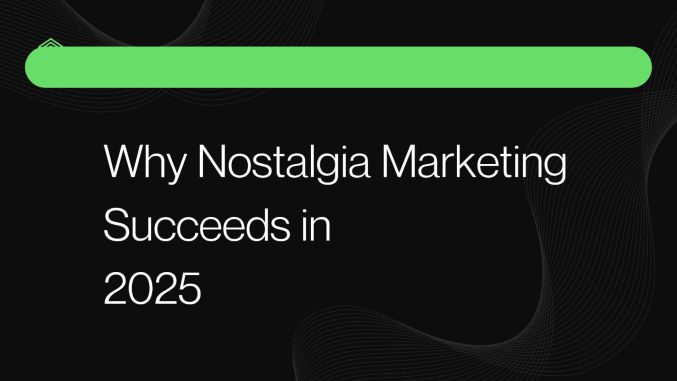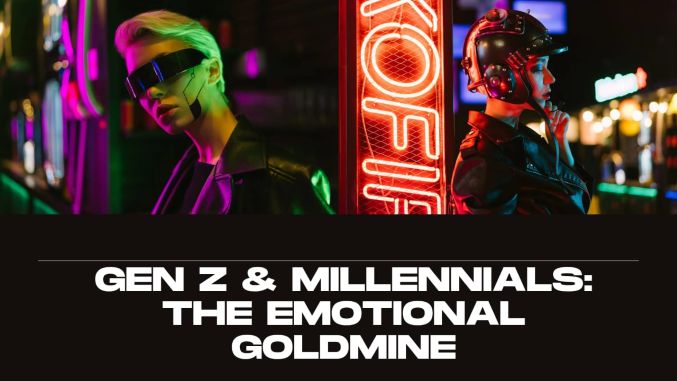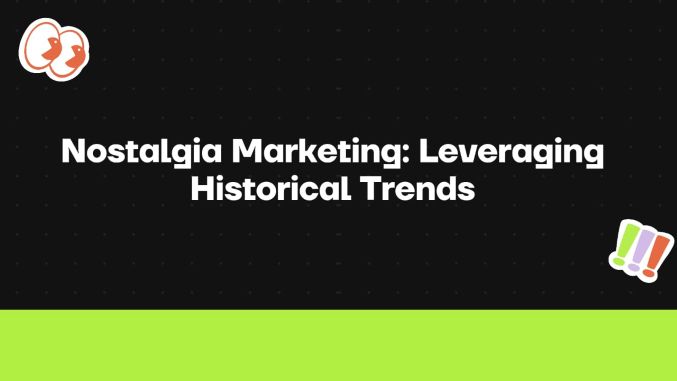Nostalgia Marketing: Leveraging Historical Trends to Make an Impact with Contemporary Audiences
In the hyper-digital, rapidly changing consumer world of today, where trends are born and die in the blink of an eye, brands are finding an unlikely yet incredibly powerful way to break through the clutter: nostalgia marketing. By leveraging the shared memories, looks, and cultural references of yesteryear, businesses are creating rich emotional bonds with contemporary audiences.
But why is nostalgia—a feeling long linked with private reminiscence—today one of the most persuasive tools in a marketer's kit? How are brands effortlessly merging retro inspiration with modern messaging to produce campaigns that resonate across generations? And why 2025 is the ideal time for nostalgia to take over branding strategies?
This definitive handbook will delve into the psychology, implementation, and prospects of nostalgia marketing, featuring real-world examples, practical recommendations, and insight into future trends.

1. Introduction: Why Nostalgia Marketing Succeeds in 2025
The Past Shapes the Future: A Cultural Phenomenon
Walk into any mall, scroll through TikTok, or flip through a fashion magazine in 2025, and you’ll immediately notice a fascinating trend: the past is everywhere. From the resurgence of Y2K fashion (think velour tracksuits, tiny sunglasses, and bedazzled flip phones) to Netflix’s Stranger Things reigniting ‘80s synth-pop and Dungeons & Dragons mania, nostalgia isn’t just a fleeting trend—it’s a full-blown cultural movement.
Brands aren't simply nodding to the past; they're redesigning it, mixing old looks with new thinking to invent something new but nostalgic. But why now?
The Science of Nostalgia: Why Our Brains Love the Past
Nostalgia isn't simply a sentimental indulgence—it's a neurological phenomenon. Psychology and consumer behavior studies show that nostalgia:
- Triggers Dopamine & Serotonin: Remembering fond memories releases happy chemicals, so consumers equate positive feelings with nostalgic branding.
- Creates a Sense of Belonging: Collective cultural memories (e.g., '90s cartoons, early 2000s music) create community, so brands that invoke them feel like old friends.
- Counters Digital Fatigue: In a world of information overload, nostalgia provides comfort and simplicity, serving as a mental refuge from the complexity of contemporary life.
According to a 2024 Harvard Business Review study, 72% of consumers prefer to buy from brands that trigger nostalgia, demonstrating that emotional recall is not only a creative strategy—it's a money maker.

2. The Resurgence of Nostalgia in Contemporary Branding
Why Nostalgia is Sweeping 2025's Marketing Scene
A number of cultural and technological changes have ushered nostalgia into the marketing limelight:
1. The 20-Year Nostalgia Cycle in Full Swing
Historically, nostalgia reaches its peak about 20-30 years after the prime of a trend, since now those who lived through it in their early years have disposable income and cultural sway.
- Early 2000s (Y2K) Revival: Gen Z, who came of age in the 2000s, now spearheads trends such as low-rise jeans, frosted lip gloss, and flip phone looks.
- '90s Minimalism & Grunge: Millennials are driving the revival of Doc Martens, Nirvana apparel, and minimalist aesthetics akin to '90s Apple advertisements.
- '80s Synthwave & Retro-Futurism: TV series such as Stranger Things and Cobra Kai have popularized '80s neon, arcades, and vintage technology.
2. The Role of Social Media in Nostalgia Amplification
Social media platforms such as TikTok, Instagram, and Pinterest have turned into nostalgia incubators:
- #ThrowbackThursday and #90sKid hashtags keep retro trends alive.
- Algorithmic virality translates to niche nostalgia (VHS filters, Tamagotchis) coming back overnight.
- Online communities (such as Tumblr's revival) enable enthusiasts to share in reliving the past together.
3. Industries Fully Leaning Into Nostalgia
Pretty much every industry is tapping into the power of nostalgia:
- Fashion: Companies such as Urban Outfitters offer purses shaped like cassette tapes, and Nike re-releases retro sneakers (Air Jordans, Dunk Lows).
- Food & Beverage: Pepsi’s retro logo, Kraft’s “Throwback Mac & Cheese”, and Taco Bell’s ‘90s-themed merch drops prove nostalgia sells.
- Tech & Gaming: PlayStation’s Classic Console, Nintendo’s Game & Watch reissues, and Meta’s VR ‘90s-themed worlds tap into generational memories.

3. Tumblr-Era Aesthetics: A Case Study in Digital Sentiment
What Defined the Tumblr Era?
For Millennials and older Gen Z, Tumblr (2010-2016) was a cultural hub defined by:
- Grunge filters (washed-out colors, high contrast)
- Indie aesthetics & music (Lana Del Rey, Arctic Monkeys, soft grunge)
- Lo-fi, DIY imagery (polaroid-style post-processing, handwritten lyric graffiti)
The Ways Brands Leaned into the Tumblr Comeback
- Glossier: Adopted Tumblr's "effortless cool" through dewy skin makeup and simplified packaging.
- Urban Outfitters: Sold band t-shirts, vinyl records, and vintage cameras to attract retro-nostalgic digital natives.
- Spotify: Offered "Tumblr Throwback" playlists with artists like The 1975 and Lorde.
Lesson? Authenticity is key—brands that truly know the subculture win, while those trying too hard fail.

4. Gen Z & Millennials: The Emotional Goldmine for Nostalgia
Why These Generations Answer So Profoundly
- Millennials (1981-1996): Now in their 30s-40s, they yearn for the simplicity of childhood (consider Disney+ reboots, Pokémon GO).
- Gen Z (1997-2012): Longing for their first digital memories (Webkinz, Minecraft, Vine).
Emotional Triggers That Resonate
- Sensory nostalgia (scratch-and-sniff stickers, old-school video game sounds)
- Shared cultural moments (McDonald’s Szechuan sauce hype, Harry Potter rereleases)
- Limited-edition throwbacks (e.g., Oreo’s “1990s Packaging” campaign)
5. Brand Examples That Nailed Nostalgia Marketing
1. Pepsi’s Retro Can Campaigns
- Reintroduced ‘90s logo and design, sparking viral unboxing videos.
- Sales spiked 18% among Millennials.
2. Instagram’s “Throwback Filters”
- AR filters mimicking 2000s webcam quality and VHS glitches drove engagement.
3. Netflix’s Stranger Things
- Revived ‘80s music, fashion, and tech, leading to a surge in Walkman sales.
4. Nike’s Sneaker Re-Releases
- Jordan 1s, sold-out Air Max 95s: nostalgia powers hype culture.
6. Visual Branding & Design: Redesigning the Past for the Future
Why Retro Aesthetics Are Taking Over 2025's Design Trends
With digital oversaturation in full effect, brands are adopting retro-futurism, Y2K glitch art, and '90s grunge as a means of differentiation. The secret? Blending nostalgia with modernity—distilling vintage-inspired elements while leaving the total experience feeling fresh.
Key Visual Trends in Nostalgic Branding
Color Palettes That Stir Emotion
- '80s Neon: Hot pinks, electric blues, and laser greens (employed by Cyberpunk 2077 and Ugly Drinks)
- '90s Pastels: Beige, mint green, and pale lavender (Glossier packaging, A24 film aesthetic)
- Y2K Metallics: Chrome, holographic, and iridescent finishes (Samsung's vintage flip phone, Balmain 2024 runway)
Typography: Grunge to Pixel Art
- '90s Grunge Fonts (Imagine Nirvana album artwork—employed by Vans and Urban Outfitters)
- Early 2000s Pixel Fonts (Minecraft, vintage gaming apparel)
- '70s Disco Lettering (Spotify's "Throwback Hits" playlists)
Packaging & Merchandise: The Power of Tactile Nostalgia
- Limited-edition throwback packaging (Oreo's "1990s Cookie Design", Coca-Cola's "Classic Contour Bottle")
- Vintage tech-inspired products (Logitech's retro keyboard, Polaroid's reissued cameras)
Case Study: How Adobe Revived the '90s with Its "Creative Nostalgia" Campaign
- Used Windows 95-inspired UI elements in social media ads.
- Released a "Retro Photoshop Filter" emulating early digital art.
- Result: 42% increase in engagement from Millennial designers.
7. Nostalgia Marketing Mistakes to Avoid
Why Nostalgic Campaigns Fail (And How to Correct Them)
Though nostalgia is potent, missteps render brands look out of touch, corny, or worse—inauthentic.
1. Overdoing the Retro Aesthetic (And Appearing Dated, Not Cool)
- Example: A company applying too much '80s neon without contemporary context threatens to appear like a costume party.
- Solution: Mix retro elements with streamlined, modern design (e.g., Apple's colorful iMacs compared to actual 1998 computers).
2. Getting the Audience's Nostalgia Wrong
- Example: A campaign targeting Gen Z that mentions The Beatles (they resonate more with One Direction or 2010s memes).
- Correction: Apply generational nostalgia mapping—Millennials adore Toy Story, Gen Z adores Club Penguin.
3. Not Remembering the Story Behind the Nostalgia
- Example: A breakfast cereal brand reviving '90s mascots without context seems lazy.
- Correction: Have a story—such as Netflix's "Is It Cake?" riding off early 2000s game shows.
4. Overlooking Data on Nostalgia Preferences
- Example: Let's assume all Millennials adore F.R.I.E.N.D.S. (most favor The Office or Scrubs).
- Fix: Use social listening tools (Google Trends, TikTok analytics) to determine actual nostalgia drivers.
8. How to Craft an Effective Nostalgia Marketing Campaign
Step-by-Step Guide to Using Nostalgia in 2025
1. Determine Your Audience's Nostalgic Era
- Gen Alpha (2013+) → Minecraft, iPad generation, early YouTube
- Gen Z (1997-2012) → Vine, Webkinz, Disney Channel
- Millennials (1981-1996) → Tamagotchis, Blockbuster, AIM chat
2. Select the Right Medium
- Social Media: VHS-tape or MySpace-profile-filtering TikTok trends.
- Product Design: Exclusive Game Boy-shaped chargers (such as HyperX's Nintendo collab).
- Experiential Marketing: Pop-up *'90s-themed diners* (look at Burger King's "Retro Whopper" campaign).
3. Mix Nostalgia with Current Values
- Sustainability: Eco-friendly nostalgia in Patagonia's vintage collections.
- Inclusivity: Diverse "Throwback Dolls" from Barbie resonate more than unaltered re-releases.
4. Measure Emotional Impact
- Monitor sentiment analysis (Are people saying it's "cringe" or "iconic"?).
- Monitor UGC (User-Generated Content)—did fans remake your campaign?
Case Study: How Lego Mastered Nostalgia
- Re-released ‘80s and ‘90s sets (Castles, Space themes).
- Partnered with Stranger Things for a Upside Down-themed set.
- Result: Adult Lego sales grew 27% in 2024.
9. The Future of Nostalgia Marketing
What’s Next? AI, VR, and the Risk of Nostalgia Fatigue
1. AI-Generated Nostalgia
- Deepfake tech bringing back retro celebrities (e.g., *Pepsi’s AI-rendered ‘90s Britney ads*).
- Generative AI tools creating fake ‘80s movie trailers for brands.
2. VR/AR Recreating Lost Experiences
- Meta's '90s-themed VR environments (AOL chatrooms, Blockbuster video rentals).
- Snapchat AR filters that simulate vintage video games (e.g., Pokémon Snap).
3. Will Nostalgia Fatigue Set In?
- Risk: Overuse may make nostalgia seem tacky (e.g., too many "Remember this?" status updates).
- Solution: Innovate, not copy—like Taylor Swift's "Eras Tour", which reimagined nostalgia.
10. Conclusion: Blending the Past with the Present
Key Takeaways
✅ Nostalgia succeeds because it's emotional, not merely aesthetic—releasing dopamine and trust.
✅ Gen-z nostalgia is different—Millennials ≠ Gen Z ≠ Gen Alpha.
✅ Design is important—retro colors/fonts need to feel deliberate, not dated.
✅ Story > gimmicks—why should audiences care about this nostalgia piece?
✅ The future is AI/VR nostalgia—but balance innovation with authenticity.
Final Thought
Nostalgia marketing isn't about being stuck in the past—it's about re-packaging memories in a way that makes something new. Brands that get this balance right (such as Netflix, Nike, and Lego) don't sell products—they sell emotional time machines.
What's your go-to nostalgia-based campaign? Tell us in the comments!


Comments
No Comments To Display